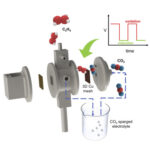2022-09-23 アメリカ合衆国・タフツ大学

・ タフツ大学が、シルクタンパク質(フィブロイン)をパーフルオロカーボンで化学的に修飾した、超撥水性ノンスティックのシルク材料作製技術を開発。
・ 化学修飾したフィブロインは、プラスチックのような形態に成型したり、フィルムとして表面に塗布できる。一般的な調理器具のノンスティック特性を大幅に上回り、様々な消費者向け製品や医療製品への用途拡大が期待できる。
・ 蚕が紡ぐ天然の繊維のシルクは、耐久性のある高級織物や外科用縫合糸の製造に数千年にわたり使用されている。
・ ごく最近ではシルク繊維を構成要素のフィブロインに分解する手法が開発され、ゲル、フィルムやスポンジ等に再構成し、整形外科用インプラントネジからテキスタイルインクまで様々な製品の製造に利用されている。シルクの特殊性は、多様な形態・形状をとれることに加え、フィブロインの化学修飾でそ
の特性を容易に変更できることにある。
・ 他のノンスティック加工プロセスとは異なる、温和な条件下で安全な化学合成プロセスによりパーフ
ルオロカーボンでフィブロインの表面を覆い、親水性のフィブロインの表面に撥水性を付与した。
・ フィブロインを覆う同物質の分子鎖の数と長さを変えることで撥水の度合を調整し、シルクの表面が
ノンスティックに達するレベルを特定。パーフルオロカーボンは、他の化学物質との反応や身体のタンパク質・化学物質との相互作用のない極めて安定した化学物質で、分子同士の結合を促す他種の力による引力にも抵抗する。
・ 最高レベルの撥水性のノンスティックシルクの表面に水を落とすと丸まった粒となり、Teflon を超える撥水性を提示。食品、血液や細胞等の水を多く含む物質も同様にはじく。今回は試験を実施していないが、パーフルオロ化した材料は、油分もはじくことが知られている。
・ 市販のノンスティックコーティングから身体に吸収される化学物質が懸念されるが、ノンスティック
ルクは比較的安全な選択肢として、ワイパーを使用しなくとも雨粒が転げ落ちる自動車のフロントガラスや、錆を防止する金属コーティング、洗濯が簡単な衣類等の用途が考えられる。
URL: https://now.tufts.edu/2022/09/23/scientists-use-modified-silk-proteins-create-new-nonstick-surfaces
<NEDO海外技術情報より>
関連情報
ChemBioChem 掲載論文(アブストラクトのみ:全文は有料)
Towards Non-stick Silk: Tuning the Hydrophobicity of Silk Fibroin Protein
URL: https://chemistry-europe.onlinelibrary.wiley.com/doi/10.1002/cbic.202200429
Abstract
Silk fibroin protein is used in myriad biomaterial applications. We showcase covalent decoration of silk with long-chain fluorocarbons, thereby converting it into a material more hydrophobic than Teflon! ′Non-stick′ silk bars fabricated in this fashion maintain structural integrity and show dramatically reduced water uptake and will be useful in directing bioorthogonal non-covalent interactions.
Abstract
Silk fibroin protein is a biomaterial with excellent biocompatibility and low immunogenicity. These properties have catapulted the material as a leader for extensive use in stents, catheters, and wound dressings. Modulation of hydrophobicity of silk fibroin protein to further expand the scope and utility however has been elusive. We report that installing perfluorocarbon chains on the surface of silk fibroin transforms this water-soluble protein into a remarkably hydrophobic polymer that can be solvent-cast. A clear relationship emerged between fluorine content of the modified silk and film hydrophobicity. Water contact angles of the most decorated silk fibroin protein exceeded that of Teflon®. We further show that water uptake in prefabricated silk bars is dramatically reduced, extending their lifetimes, and maintaining mechanical integrity. These results highlight the power of chemistry under moderate conditions to install unnatural groups onto the silk fibroin surface and will enable further exploration into applications of this versatile biomaterial.



